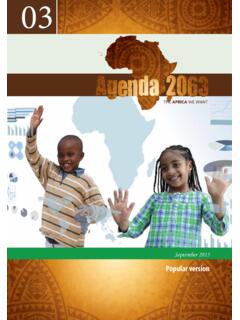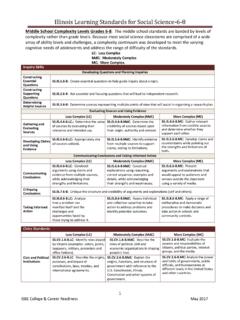Transcription of Promoting Social Integration - United Nations
1 Promoting Social Integration : Economic, Social and Political Dimensions with a focus on Latin America (first draft 07-02-08). Maria Amparo Cruz-Saco Economics Connecticut College, USA. Paper prepared for the United Nations , Department of Economic and Social Affairs, Division for Social Policy and Development in collaboration with the Government of Finland, Expert Group Meeting, Promoting Social Integration , 8-10 July, 2008, Helsinki, Finland. Introduction Social Integration is a highly desirable outcome that reflects the existence of Social cohesion, a strong institutional foundation and a culture of acceptance.
2 Societies are better off if they promote Social Integration through inclusive policies that reduce economic inequality and poverty, and promote sustainable and equitable development. The concept of development used in this paper is best defined by Amartya Sen (1999, ), the process of expanding human freedoms, , freedoms associated with avoiding deprivations, being literate, enjoying political participation, uncensored speech and so on. Because of its qualitative nature, Social Integration can be proxied by using variables that capture and measure how much Social Integration exists in a community at any given time.
3 Identifying these indicators can be tricky and it may entail using quantitative and qualitative data. Many development practitioners and policy makers center attention on the creation of economic opportunities as the material basis for Social Integration . In this way, there is often a tendency to underscore economic goals and make them uniquely critical. In developed countries, the goals of stable, productive and decent employment and poverty elimination have been firmly grounded in Social contracts and have therefore influe nced labor and welfare policies in meaningful ways.
4 European Social democracies have been engaged in attaining socio-economic goals that bring stability and Social cohesion both within each individual nation and within the European Union. In contrast, the developing world has faced persistent obstacles in its efforts to attain these twin goals despite its recent economic expansion. In Latin America, average growth rates of three per cent in the last fifteen years have not contributed to a substantial increase in productive employment or the substantial reduction of poverty. While Social Integration is more viable when societies move toward sound economic goals, there are key non-economic elements that are part of building integrated and cohesive societies.
5 In this paper I will review critical links that exist between economic, Social and political variables in the quest to reach societies that are more just and fair for all citizens. I will refer to the case of Latin America to discuss the roles played by policies and programs that build communities, increase participation and representation, and promote leadership opportunities among families, the youth, and local communities. The goal of Promoting Social inclusion through actions that eliminate discrimination and other forms of intolerance and rejection is as important as the creation of economic opportunities.
6 These actions can be organized in four categories: economic, Social , political and cultural. Using these categories, I suggest a framework (scorecard) that can be used to assess Social Integration goals. The paper's main findings and recommendations are presented at the end. What is Social Integration ? Social Integration is the process of creating unity, inclusion and participation at all levels of society within the diversity of personal attributes so that every person is free to be the person she wants to be. Personal attributes include socio-economic class, age, gender - sexual preference and expression, political ideas, ethnicity and cultural traits, religion, citizenship (national origin) and geographical region of origin and so on.
7 Social Integration enables persons, regardless of their attributes, to enjoy equal opportunities, rights and services that are available to the so-called mainstream group. Social Integration can be considered to be antonym to Social exclusion, which is broader than poverty and deprivation, and which neglects people's rights. Social exclusion is produced by systematic and institutional discrimination and other forms of rejection that leave out persons or groups from the mainstream system of economic, Social , and political relationships.
8 Access to these relationships enables the privileged to be active participants in society benefiting from cultural, economic, Social and political exchanges. Excluded persons and groups do not partake in the benefits of Social capital with identical sense of belonging. And in worse situations, the intensity of rejection and intolerance can create emotional and physical harm to excluded persons. To protect themselves, victims of discrimination and intolerance form smaller and tightly connected networks of solidarity and support among themselves and their allies in safe places.
9 The elimination of Social exclusion through programs and actions that integrate vulnerable persons into mainstream society is a required condition for the creation of economic opportunities for these populations. Evidence shows that in many countries failure to reduce marginalization and vulnerability of populations at risk can be explained by policies that considered economic goals as key determinants and Social aspects as secondary elements. Cultural sensitive programs, however, that have built bridges and developed capabilities to support people in need have been effective in reducing poverty and building stronger communities.
10 In a nutshell, Social Integration : eradicates stereotypes and ( mainstream ) privilege, 2. increases the voice of persons or groups that are vulnerable and have been marginalized, creates opportunities for their political participation, creates stable and decent job opportunities for traditionally underrepresented persons and groups, and promotes the development of capabilities among vulnerable populations so that they can overcome poverty and deprivation. Non-economic causes of Social exclusion Persons who have not socialized in multi-cultural environments lack the competence to relate to people who look different or are different although they may look alike.












